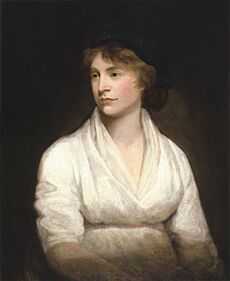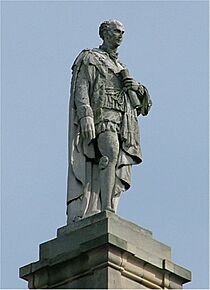Reformism (historical) facts for kids
Reformism is about making changes to improve a society or a political system. Think of it as trying to make things better and fairer for everyone.
Reform movements are different from revolutionary movements. Revolutionaries want to completely throw out the old system and start fresh. Reformers, however, usually work within the existing system to make changes. Their ideas often come from beliefs like liberalism (which values freedom and equality), or sometimes from socialist or religious ideas.
Some reform movements focus on changing individuals, while others work on small groups. For example, Mahatma Gandhi's movement encouraged people to spin their own cloth and create self-sufficient villages.
Sometimes, there are also "reactionary movements." These groups try to stop reforms or even bring things back to how they were before any changes happened.
Contents
United Kingdom
After many years of very traditional rule, big changes started happening in the late 1820s in the United Kingdom. Old rules that limited non-Anglican Christians were removed, and then major restrictions on Catholics were also lifted.
The Radical movement was a group that pushed for many important changes. They wanted to reform how people voted, stop child labour, improve laws for the poor, encourage free trade, make education better, fix prisons, and improve public health with better sanitation.
At first, this movement wanted to take political power away from the rich aristocracy. They wanted a more democratic system that would give more power to people in cities and to the middle and working classes. Much of the energy for these reforms came from religious groups, especially the Methodists.
Reformers also used scientific methods, like those from Jeremy Bentham, to plan specific changes. They wanted to make sure the government could check if reforms were working well.
The biggest success for the reformers was the Reform Act 1832. This law gave more political power to the growing middle classes in cities. It also greatly reduced the power of areas with very few people that were controlled by rich families. Even though the House of Lords strongly resisted, this Act gave more power to liberal politicians. However, it also reduced the political strength of the working class, who felt left out. After the 1832 Reform Act, the Radical groups split up for a while.
Chartist movement
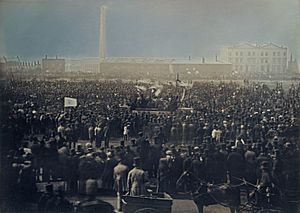
The Chartist movement in Britain during the 1800s wanted universal suffrage, meaning everyone should have the right to vote. One historian said that the Chartist movement was mainly about economic problems, but it used political goals to achieve them.
At that time, there was bad trade and high food prices. Also, strict rules about help for the poor caused a lot of hardship. Groups like the London Working Men's Association saw great unrest. In northern textile areas, Chartists led by Feargus O'Connor spoke out against the unfair Poor Laws. This movement was largely a "hunger revolt" caused by unemployment and despair.
The Chartist movement demanded basic economic changes, like higher wages and better working conditions. They also wanted to get rid of the disliked Poor Law Act.
One of their main goals was universal male suffrage, which meant all men should be able to vote, no matter their social status. This idea later grew into a campaign for all adults to vote. The movement also wanted to redraw parliamentary districts so they were fairer. They also pushed for elected officials to be paid, so that working people could afford to represent their communities in Parliament.
Women's rights movement
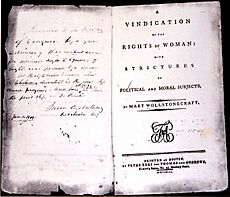
Many people see Mary Wollstonecraft's book A Vindication of the Rights of Woman (published in 1792) as the start of the long fight for women's rights and the beginning of the Women's Suffrage movement. Harriet Taylor Mill greatly influenced John Stuart Mill's ideas and his support for women's rights. Her essay, "Enfranchisement of Women," was published in 1851.
A strong campaign to allow women to vote began in Victorian times. Emmeline Pankhurst's husband, Richard Pankhurst, supported women's right to vote. In 1889, Emmeline Pankhurst started the Women's Franchise League, which was not successful. Then, in 1903, she founded the more famous Women's Social and Political Union (later called 'suffragettes' by a newspaper). This group was known for its strong and sometimes aggressive actions.
Led by Pankhurst and her daughters, Christabel and Sylvia, the campaign reached its peak in 1918. That year, the British Parliament passed the Representation of the People Act 1918. This law gave women over 30 the right to vote if they owned a home, were married to a homeowner, rented property, or were university graduates.
Reform in Parliament
Earl Grey, Lord Melbourne, and Robert Peel were important leaders in Parliament during the early years of the British reform movement. Grey and Melbourne were part of the Whig party. Their governments oversaw parliamentary reform, the end of slavery throughout the British Empire, and changes to the Poor Laws. Peel was a Conservative. His government took a big step towards tariff reform by getting rid of the Corn Laws.

William Ewart Gladstone was also a great reformer. Among the changes he helped Parliament pass was a system for public education with the Elementary Education Act 1870. In 1872, he introduced the secret ballot to stop people from being forced, tricked, or bribed when voting. By 1885, Gladstone had also redrawn the parliamentary district lines. He made each district equal in population, so that no one Member of Parliament had more influence than another.
United States: 1840s–1930s
Many reform movements took place in the United States during this period:
- Religion: Many Protestant churches, especially the Evangelical ones, were active in reforms in the mid-1800s. These included movements against alcohol (temperance) and for ending slavery (abolition). This was part of the Second Great Awakening.
- Art and Literature: The Hudson River School created a unique American art style, showing beautiful landscapes. The Transcendentalist movement started in literature and supported many reforms.
- Utopian Experiments: Some groups tried to create ideal communities:
- New Harmony, Indiana: Founded by Robert Owen, this community tried to share everything. It didn't last long because of social problems.
- Oneida Commune: Founded by John Noyes, this group lived together and supported themselves by making silverware. The company still exists today!
- Shakers: Founded by Mother Ann Lee, they expressed their faith through dance and made popular furniture.
- Educational Reform: Led by Horace Mann, this movement aimed for better and more accessible education. Noah Webster's dictionary helped standardize English spelling. William McGuffey's popular children's books taught reading step-by-step.
- Women's rights Movement: This movement was started by Lucretia Mott and Elizabeth Cady Stanton. They organized the Seneca Falls Convention in 1848 and wrote a Declaration of Sentiments asking for equal rights for women. Lucy Stone and Susan B. Anthony also worked tirelessly for women's suffrage (the right to vote).
- American Labor Movement: A major goal for workers in the 1800s was to reduce long working hours and achieve the eight-hour day. Groups like the Knights of Labor and later the American Federation of Labor (now part of the AFL–CIO) fought for workers' rights.
- Child Labor Reform: Lewis Hine used his camera to take powerful photographs of child workers. His pictures were very important in changing child labor laws in the United States.
- Abolition Movement: This movement worked to end slavery. After the Mexican–American War in 1848, there was a risk that slavery would spread to new territories. Key figures like William Lloyd Garrison and Frederick Douglass spoke out against the terrible conditions of enslaved people.
- Prohibition or Temperance movement: This movement aimed to ban or limit alcohol. Important groups included Frances Willard's Woman's Christian Temperance Union and Carrie Nation's Anti-Saloon League.
Mexico: La Reforma, 1850s
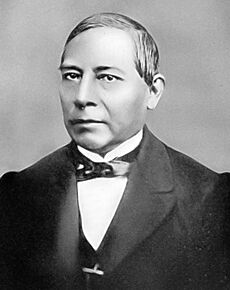
The Mexican Liberal Party, led by Benito Juárez and Sebastián Lerdo de Tejada, helped Mexico become a modern nation state after years of colonialism. They wanted a modern society and a capitalist economy.
Their program, written in the 1857 Constitution of Mexico, included:
- Making all citizens equal before the law. Mexico had already ended slavery in 1829.
- Ending special legal protections for the church and military.
- Breaking up large communal land holdings and giving land titles to farmers.
- Selling off large amounts of church property that wasn't needed for religious purposes.
- Stopping the church from charging very high fees for religious services.
- Ending separate courts for the military and church.
- Guaranteeing Freedom of religion and many civil and political freedoms.
- Creating secular public education (education not controlled by the church).
- Setting up civil registries for births, marriages, and deaths.
- Getting rid of cruel and unusual punishment, including the death penalty.
- Ending debtor's prisons and all forms of personal servitude.
Ottoman Empire: 1840s–1870s
The Tanzimat, which means reorganization, was a period of reforms in the Ottoman Empire. It started in 1839 and ended in 1876. The Tanzimat reforms tried to modernize the Ottoman Empire and protect its lands from nationalist movements and powerful countries.
The reforms encouraged "Ottomanism," a sense of shared identity among the many different ethnic groups in the Empire. This was an attempt to stop nationalist movements from breaking the Empire apart. The reforms also tried to include non-Muslims and non-Turks more fully into Ottoman society by giving them more civil rights and equality. However, peasants often didn't like the reforms because they changed traditional ways of life.
Russia 1860s
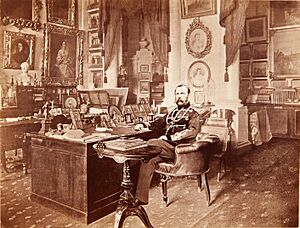
In the 1800s, the Russian Empire was very traditional and ruled by powerful tsars. A big exception was during the rule of Alexander II (1855–1881), especially in the 1860s. The most important and surprising change was the end of serfdom.
Emancipation of the serfs 1861
The emancipation reform of 1861 freed 23 million serfs. This was the most important event in 19th-century Russia. It marked the beginning of the end for the rich landowners' power.
When serfs were freed, they could move to cities, which helped industries grow. The middle class also grew in size and influence. However, the freed peasants did not get any free land. They had to pay a special tax for most of their lives to the government. The government then paid the landlords a good price for the land they lost. All the property given to the peasants was owned by the mir, which was the village community. The mir divided the land among the peasants.
Even though serfdom ended, the way it was done was not good for the peasants. This meant that revolutionary feelings did not go away, even though Alexander II wanted them to. Revolutionaries believed that the newly freed serfs were just being forced into wage slavery as the industrial revolution began.
Judicial reforms
The changes to the legal system were some of Alexander II's most successful reforms. A completely new court system was created. The main results were a single judicial system instead of many complicated courts. There were also big changes in criminal trials.
These changes included:
- Making sure all parties in a trial were equal.
- Having public hearings.
- Introducing jury trials.
- Having professional lawyers, which was new in Russia.
However, there were still some problems. Some old institutions were not covered by the reforms. Also, later tsars, Alexander III and Nicholas II, often used punishment outside of the legal system. One of the most important results was the widespread use of jury trials. A jury trial included three professional judges and twelve jurors. Jurors had to own property. Unlike today, jurors could decide if someone was guilty or not guilty, or even guilty but not to be punished. Alexander II believed that justice needed morality. The professional judges then gave the sentence.
Additional reforms
Many other reforms followed. The tsar appointed Dmitry Milyutin to make important changes to the Russian army. There were also important changes for industry and trade, which led to many new companies. Plans were made to build a large network of railways to help develop the country's resources and improve its defense.
Military reforms included making all social classes serve in the army starting in 1874.
A new legal administration (1864), based on the French system, made sure judges stayed in their jobs. A new penal code and a much simpler system for civil and criminal cases were also put in place. The court system was reorganized to include open trials, judges appointed for life, a jury system, and local justices of the peace for minor offenses.
Alexander's government also created a system of local self-government called zemstvo for rural areas (1864) and large towns (1870). These elected groups had limited power to collect taxes and managed a new rural and city police force.
The Alaska colony was losing money and would be hard to defend against Britain during wartime. So, in 1867, Russia sold Alaska to the United States for $7.2 million. Russian administrators, soldiers, and some priests returned home. Others stayed to serve their native church members, who are still part of the Russian Orthodox Church today.
Turkey: 1920s–1930s
Atatürk's Reforms were a series of major political, legal, cultural, social, and economic changes. They were put into action under the leadership of Mustafa Kemal Atatürk in the 1920s and 1930s in the new Republic of Turkey.
Between 1919 and 1923, Mustafa Kemal led the Turkish War of Independence. He worked to get rid of the old ways of the Ottoman Empire and build the foundations of the new Turkish State. He organized national meetings to bring people together and boost their spirits against the Allied Powers who were occupying Anatolia. Through these meetings, he showed that old ideas of imperialism should be dropped. He believed that people within national borders should make their own decisions.
After Istanbul was occupied by the Allied Powers, he laid the groundwork for the new Turkish State. In 1920, he brought together the Great National Assembly in Ankara. As president of this new government, Mustafa Kemal fought against the Allied Powers and the Sultan's army, which was working with the occupiers. Finally, in September 1922, he succeeded in driving the Allied Forces out of Izmir and other parts of Anatolia. By doing this, he saved the country from foreign invasion.
See also
- Reform Judaism
- Revitalization movement, movements that transform societies and cultures
- The Venus Project
- Big tent
- Structural fix


